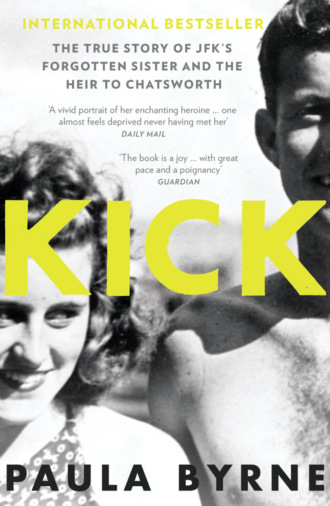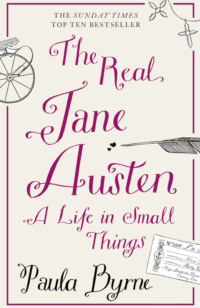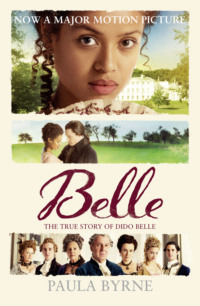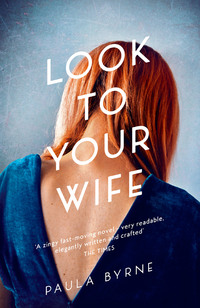
Полная версия
Kick: The True Story of Kick Kennedy, JFK’s Forgotten Sister and the Heir to Chatsworth
There was a team of nannies and nursery maids dedicated to looking after the children in the absence of the parents. Joe’s closest friend and adviser was an old friend of Honey Fitz, a man called Edward Moore. He and his wife Mary were childless and they became surrogate parents to the Kennedy children. When Rose and Joe were away, the Moores stepped in to help.
In the days after Jean’s birth, a huge bouquet of flowers was delivered to St Margaret’s Hospital from the actress Gloria Swanson, congratulating Rose on the birth of her child. Joe finally arrived from Palm Beach at his wife’s bedside, carrying three expensive diamond bracelets. This was not just a gift for having the baby, it was a guilt present. What did Rose really think when she looked at Gloria Swanson’s bouquet of flowers and the diamond bracelet glittering on her arm? It was an open secret that Joe and Gloria Swanson were in the throes of a passionate affair.
They had met for the first time in November 1927. Gloria was just twenty-eight, beautiful, charismatic and perhaps the most famous movie star in the world. She looked like a younger, more glamorous version of Rose. She had the same black, glossy hair, luminous skin and sapphire-blue eyes. Joe was utterly captivated. She could further his reputation as a serious studio head. He was tired of making B movies and cowboy films. He saw the way Hollywood was going – talkies. He wanted a business partnership with the screen goddess and he wanted her for himself. When they first met for dinner to discuss their partnership, Joe assured her, ‘Together we could make millions.’10 He offered to manage her, promising that he would reduce her debts and make her an even bigger star.11
The affair was to be a lasting one, and it posed a serious threat to his family. Gloria was utterly unlike the usual chorus girls that had previously attracted Joe. Before her, it was easy for him to compartmentalize his sexual affairs and his love for Rose. Rose was his wife, the mother of his children; the showgirls were there just for sex and for fun. Gloria was in an entirely different category.
Joe, more than ever, began to lead a bifurcated life, between his wife and large brood of handsome children and the glamorous movie star, the ultimate trophy mistress. In October 1928, he invited Gloria to a Halloween party in Riverdale along with her children. Gloria initially refused to meet the wife of the man she was sleeping with. But she did allow her children to go to the party. Her daughter, known as ‘little Gloria’, was the same age as Kick. She remembered the party with the decorations and all of the Kennedy children.
Kick was intrigued to meet the daughter of the world’s most famous movie star. She liked little Gloria, and took her to her Bronxville school to meet her schoolfriends. She introduced her guest as ‘Gloria Swanson’s daughter’. The other girls laughed and thought it was a joke: ‘After all, Gloria Swanson was, to them, practically a supernatural being, so she wouldn’t be in Bronxville.’12 Kick was indignant that nobody believed her story.
She liked her new friend, but she longed even more to meet the beautiful star herself. She wouldn’t have to wait long. The seriousness of the love affair was evident from Joe’s deliberate and highly risky merging of his two lives. He was adamant that his star, Gloria Swanson, should meet the family.
4
Hyannis Port

Our whole lives were centered in this one place.
Teddy Kennedy1
August 1929.
A chorus of residents and vacationers in the small seaside-resort town of Hyannis Port huddled excitedly around the harbour overlooking Nantucket Sound. In the distance they heard the buzzing of the Sikorsky amphibious plane, watched it flying low over the sea before it landed gracefully on the water and came to a halt: a more dramatic entrance could not be imagined, but then again, the flying boat was carrying one of the most famous women on the planet, and she was known for her love of drama.
Out from the tiny plane stepped Gloria Swanson. There was her lover, Joe Kennedy, in his launch, piloting her back to the shore where his wife waited to greet her. The women looked so eerily alike, except that the guest was nine years younger than the hostess. Joe was ecstatic at having Gloria on his arm, and, in the throes of his obsession with her, paid not the slightest attention to the whispers of his neighbours and friends. Nor did he care what his wife was thinking.
Rose was far too intelligent not to be aware of the gossip that circulated about her husband and Gloria, but she was not about to confirm the rumours, and certainly not to the nosy rubberneckers who clustered around the harbour waiting for a glimpse of the actress. Rose warmly welcomed her husband’s mistress. Gloria later mused on her rival’s sangfroid: ‘Was she a fool, I asked myself … or a saint? Or just a better actress than I was?’2 Rose was neither fool nor saint. She knew exactly what was going on and, if she thought Joe was going too far expecting her to befriend his mistress, she didn’t show it. As usual, she held her head high, dressed impeccably and put on her best show. Gloria might be Joe’s mistress, but Rose was his wife.
Nine-year-old Kick was especially excited to be meeting Gloria Swanson. She and her sisters had converted a room above the garage into a clubhouse. They pasted movie posters on the walls and discussed their favourite stars. Gloria paid a special visit and scrawled her name on the wall. Kick may have intuited that something was not as it should be. Her best friend Nancy Tenney later recalled that the girls at school had two fan clubs, one for Constance Bennett and one for Gloria Swanson. None of the Kennedy sisters wanted to be in the Swanson camp: ‘Kathleen never discussed the reason she was so adamant. I didn’t know what it was all about until years later.’3 However, Kick’s letters to her father suggest that she worshipped Gloria Swanson. Or perhaps she was following her mother’s example in pretending that Gloria was nothing more to her father than a business associate. She treasured a signed photo and constantly asked after little Gloria, with whom she began a correspondence.4
Joe was overstepping the mark in bringing his mistress to Hyannis. It was a place that was associated with family. The Kennedys considered it their true, spiritual home, the epicentre of their lives. A decade later, in 1939, Rose gave an interview to Reader’s Digest in which she set out the Kennedy family manifesto: ‘Years ago, we decided that our kids were going to be our best friends and that we could never see too much of them.’ Rose explained that, with her husband’s hectic schedule, it wasn’t possible to have friends, and go to dinner parties. Because Joe was often away from home, when he was with the family they didn’t want to share their precious time with outsiders. The substituting of children for friends meant that outsiders, close colleagues and, later, in-laws often felt excluded. The family was at once cohesive and suffocating. What Rose failed to understand was that her children needed friends with differences to kick against, in order to find out who they were. For her, family always, always came first. As she told Reader’s Digest: ‘as a result the Kennedy children became natives of the Kennedy family, first and foremost, before any city or any country’.5
Every summer, for the duration of the holidays, the whole family assembled at Hyannis Port. It was their playground, the backdrop to their lives. For generations, it would be the place to which they would return in times of triumph and tragedy. They all looked back on summers on the Cape as providing their happiest memories – the long summer vacation stretching out before them, the lazy hot days of sports and fun. The family had begun holidaying in Hyannis Port in 1924. In those days, it was not a fashionable place. The ‘Kennedy Compound’ lay far in the future. But there was good railway access, lovely sandy beaches and a golf club that was more than happy to accept Joe Kennedy as one of its members. Equally important for the Kennedys was that Hyannis Port had a Roman Catholic church. St Francis Xavier, located on South Street, was a pretty structure, built in 1874. Once called St Patrick’s Church, it changed its name to avoid giving the impression that it was an ‘Irish only’ church. This was the summer parish for the Kennedy family. Joe Jr and his brothers became altar boys.
The family rented Malcolm Cottage, a large white clapboard house with green shutters, at the end of Marchant Avenue, just a block from the sea. It had an extensive lawn where the children could play and it came with its own private beach. After renting the house for several years, Joe bought it in November 1928 and instructed the original architect Frank Paine to remodel it. Extra rooms were added, windows were widened to take in the sweeping ocean view and a large RCA sound movie theatre was built. Hyannis Port had only just got its own theatre for the talkies, so it was very spectacular that the Kennedy family had their own private facility, which showed the latest films shipped in from Hollywood.
The house was spacious but it was not grand. It was a lovely family home. Rose loved her Cape Cod garden and planted ‘old-fashioned blooms’ such as asters, chrysanthemums, calendulas, black-eyed susans and marigolds. The glorious riot of colour contrasted with the dazzling white of the clapboard house and the rich green lawn. There were butterflies, and innumerable birds: seagulls, oystercatchers, bobwhites and the beautiful red cardinal. Eagle-eyed children could spot chipmunks foraging for food. The beaches were lined with a profusion of wildflowers, in particular the hot pink wild beach rose, which emitted a strong and sweet fragrance. The family would hunt for beach plums, rose hips, elderberries, chokeberries and wild grapes.
One morning Rose bundled the children into the station wagon. They were off to forage for wild blueberries, each child carrying a tin pail. Ten miles into the wilds, they spotted a sunny patch of bushes with ripening berries and began to fill their buckets. Suddenly Eunice began screaming. A wasp had stung her, and all of the other children suddenly imagined that they, too, had been stung. Seconds later, Jack ran up yelling and waving his arms. He had sat on an anthill and ants were swarming all over him. Rose packed up the children ‘with a small harvest and my deflated educational ideas’. On the way home, they stopped off at the store and bought three quarts of blueberries: ‘I never mentioned picking blueberries again.’6 Rose had her issues, but she certainly didn’t lack a sense of humour.
Food was an important part of the Cape Cod experience. The children loved to picnic on the beach, and they would set off with a thermos jug with creamed chicken, fresh fruit, lollipops and always a chocolate cake with thick, gooey icing. They bought ice cream from the store along with a pack of cones.7 One of the favourite Kennedy desserts was Boston cream pie, a luscious confection of light fluffy sponge sandwiched together with custard cream and frosted with chocolate. There were healthy snacks, too: carrot and celery sticks, and in the evenings roast chicken, apple jelly and acorn squash.8 Alcohol was not permitted in the Kennedy household.
Above all for the sporty, wholesome clan there were the outdoor games. The children played touch football on the beach, went swimming and played competitive tennis. Rose colour-coded the children’s bathing caps so she could recognize each child in the water. Each of them (except for Rosemary) had their own sailing boat. When they raced on Nantucket Sound, Joe would follow in his own boat, shouting out their mistakes. After every race the station wagon would be dispatched to collect the trophies. When Rose wanted the children to bring the boats in, she would lower the flag from the flagpole in front of the house.9 Joe later had a pool built, and an outdoor shower was installed by a side entrance. The children could practise their diving and splash about after a day on the beach.
Kick loved to run around barefoot. She was by nature a free spirit, and she and Jack chafed against Rose’s disciplined regime. Clocks were installed in every room and the children knew not to be late for mealtimes, or they would go without. They would learn to charm the cook behind their mother’s back.
Joe would sit in his favourite chair in the corner of the living room or on his bedroom balcony (nicknamed ‘the bullpen’), looking over his brood. If the children fought or dissolved into tears over a quarrel with a sibling Joe would clap his hands in steady rhythm: ‘No – crying – in – this – house! No – crying – in – this – house!’10 He hated tears and impressed upon the children that crying accomplished nothing. Kick and Jack invented a family motto: ‘Kennedys never cry’.
On cold days they played indoor games. A favourite was ‘categories’, a trial of intellectual trivia. The children always had to be doing something.
On Sundays, they would troop downstairs in ‘Sunday Best’. Rose would be waiting at the foot of the stairs to inspect them.11 They would set off for mass at St Xavier’s, the boys preparing to do their altar-boy duty, the girls clutching Bibles and rosary beads. They were the ideal Catholic family.
Конец ознакомительного фрагмента.
Текст предоставлен ООО «ЛитРес».
Прочитайте эту книгу целиком, купив полную легальную версию на ЛитРес.
Безопасно оплатить книгу можно банковской картой Visa, MasterCard, Maestro, со счета мобильного телефона, с платежного терминала, в салоне МТС или Связной, через PayPal, WebMoney, Яндекс.Деньги, QIWI Кошелек, бонусными картами или другим удобным Вам способом.






